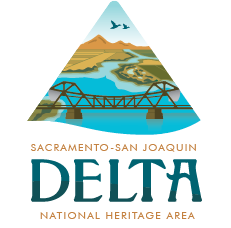A History of Travel and Transport
Within the Delta, towns were slow to develop. However, on the periphery of the Delta, three major cities formed points of a “V” for communication. Beginning in 1849, San Francisco played the central role between the outside world and the Mother Lode region. Sacramento and Stockton were critical cities for supplying the gold fields.
These two interior cities became small-scale manufacturing centers specializing in wheels, wagons, boats, and agricultural equipment. They were also collection and distribution points for mail, freight, newspapers, and overland stage traffic, and, starting in 1853, telegraphic messaging. Delta towns such as Rio Vista, Isleton, and Walnut Grove had their own service centers and some developed their own newspapers.
Early transportation was by boat rather than overland. By the mid-1850s, the steamboat was ubiquitous in the Delta and connected with freight wagons into the foothills and Sierra. In the Delta proper, long-distance travel by wagon was nearly impossible prior to levee construction, which provided surfaces for hard roadbeds. Reclamation was first done by hand labor, but as technology developed–especially steam-driven machinery–substantial dredging and draining were undertaken in a very short length of time. Steam-powered equipment from water pumps to dredges, harvesters, and tractors constituted a major technological shift, of which the Delta provided an ideal testing ground.
A parallel and interrelated change was true for crops. Farming that had included some grain growing and cattle raising began to give way to vegetable and orchard production, dependent on hand labor supplied principally by laborers representing diverse ethnic backgrounds. These garden crops were sold locally and were highly sought after. Roads were necessary to get this produce to the slough and river landings, which first required ferries and later moveable bridges to allow unobstructed boat traffic. Generally, the costs involved for production on the Delta meant that large capital sums were required. Therefore, much of the acreage involved resulted in larger landholdings, often absentee ownership by wealthy investors, and fewer small-holdings. Yet, by the 1880s, pears became an important fruit crop, often farmed by small-holders. With the advent of the refrigerated rail car, pears and other crops could be shipped east with little spoilage. At the same time, safe and inexpensive canning of fruits and vegetables was developed, and canneries were built in many places in the Delta.
Beginning in the first decade of the twentieth century large tractors and advanced agricultural machinery allowed substantial farming operations to expand and new crops to be introduced. In 1909, along the east side of the Sacramento River, a railroad was built to compete with the steamboats, and in 1929 a rail line was completed on the west side as well. In the first two decades of the twentieth century, large-scale crops included potatoes, corn, beans, celery, asparagus, onions, and by the mid-1920s sugar beets.
Commercial fishing and preservation, especially of salmon, date back to the 1850s on the Sacramento River, and for several decades were important industries. By century’s end, commercial fishing was mostly gone. Sport fishermen and recreational boaters benefited from the invention and improvement of the internal combustion engine in the form of the outboard motor.
The internal combustion engine represented a second major technological transition, one that changed patterns of trade and transportation. The motor car, truck, and bus were introduced as early as the 1910s. Trucking became increasingly important starting in the 1920s, and eventually replaced both the steamboat and the railroad as the primary means of transport. After the 1950s fresh produce could be loaded in the fields and sent long distances with refrigerated trucks. Canneries moved out of the Delta, paved highways were built, and new larger and stronger bridges were constructed.
In the later twentieth century many of the Delta’s crops differed from earlier agricultural periods. A different mode of transport changed the appearance of the Delta even from half a century earlier. It also had developed an important and large recreational industry to add to its agricultural wealth. These two activities, of substantial importance to the economy of California, assured the Delta of a prominent place in California’s agriculture and tourism industries.
